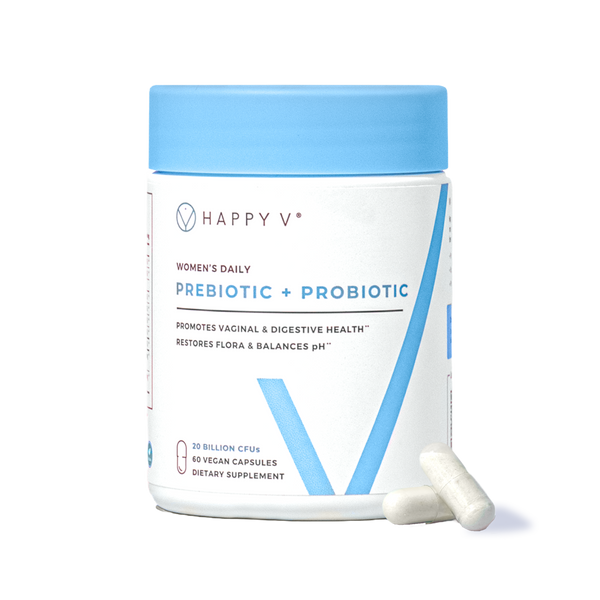- Fact Checked
- August 30, 2025
- 15 min read
Cycle Tracking 101: Why Monitoring Your Period Matters for Your Health
Table of Contents
Table of Contents
Your period isn’t just a monthly inconvenience. It’s one of the most reliable signals of your overall health. The menstrual cycle reflects how your hormones, energy, and reproductive system are working together, and tracking it can provide insights that go far beyond predicting your next period1.
Whether you’re managing PMS, trying to conceive, or noticing changes as you approach menopause, cycle tracking helps you connect the dots between your symptoms, lifestyle, and well-being. With simple tools, you can spot irregularities, plan around your fertile window, and support your reproductive health at every stage of life2.
This post is for informational purposes only and does not constitute medical advice. See full disclaimer below.
Understanding the Menstrual Cycle
Before we dive into how and why to track your period, let’s dive more into what your menstrual cycle even is. Chances are, there’s a whole lot more to it than you even realized!
The menstrual cycle is the sequence of events your body goes through each month to prepare for a possible pregnancy3. It begins with your period, when you shed the lining of your uterus, and ends when the next period starts. On average, it lasts about 28 days, but anywhere between 21 and 35 days is considered normal.
The Purpose of the Menstrual Cycle
Each cycle is part of your reproductive system’s way of preparing for pregnancy. Hormones guide your ovaries to release an egg (ovulation) and cause your uterine lining (endometrium) to thicken in case fertilization occurs. If the egg isn’t fertilized, hormone levels drop, and the lining sheds (aka you get your period)4.
Hormonal Control of the Cycle
The menstrual cycle is guided by hormones, which act as chemical messengers between your brain and your ovaries. Here’s how those hormones come into play throughout your monthly cycle:
- At the start of the cycle, the pituitary gland in your brain signals the ovaries to begin working.
- Estrogen levels rise, which stimulates the growth of small sacs in the ovaries called follicles—each containing an egg.
- Around the middle of the cycle, a sharp increase in luteinizing hormone (LH) triggers ovulation, when one mature egg is released from the ovary.
- After ovulation, progesterone becomes the dominant hormone. It prepares the uterine lining to support a possible pregnancy.
- If no pregnancy occurs, both estrogen and progesterone levels drop. This signals the uterus to shed its lining, leading to menstruation, or the start of a new cycle.
Phases of the Menstrual Cycle
The menstrual cycle follows a predictable rhythm, guided by shifting hormone levels that prepare the body for a possible pregnancy each month. Each phase builds on the one before it, with changes in the ovaries, uterine lining, and hormones working together like steps in a sequence. Understanding these phases makes it easier to see how your body moves from menstruation to ovulation and back again.
- Menstrual phase (days 1–5): You shed the uterine lining through menstrual bleeding. This overlaps with the beginning of the follicular phase.
- Follicular phase (days 1–13): Follicle-stimulating hormone (FSH) encourages several follicles to develop in the ovaries. One matures into a fully developed egg, while estrogen thickens the uterine lining5.
- Ovulation (around day 14 in a 28-day cycle): Triggered by a sudden LH surge, the mature egg is released from the ovary into the fallopian tube. This is your most fertile time6.
- Luteal phase (days 15–28): Progesterone prepares the uterus for a possible pregnancy. If fertilization doesn’t occur, hormone levels drop, signaling the next menstrual phase7.
Typical Cycle Length and Duration
One of the most common questions people ask is: “How many days between periods is normal?” The answer: anywhere from 21 to 35 days.
While the average menstrual cycle is about 28 days, cycles as short as 21 days or as long as 35 days are still considered healthy.
When it comes to period duration, most people bleed for 3 to 7 days. It’s important to remember: your normal may not look like someone else’s. Try not to compare. What matters most is knowing what’s consistent for you.
Cycle Changes Across the Lifespan
Menstruation typically begins between ages 8 and 16, with an average age of 12, and continues until menopause, which usually occurs around age 51. Your cycle may shift in length and regularity at different life stages.
- Adolescence: Cycles may be longer, shorter, or irregular for the first 2–3 years as hormones stabilize. Flow may be heavier in the beginning.
- 20s and 30s: Cycles often become more predictable and consistent.
- Postpartum and breastfeeding: Cycles may take time to return and can be irregular at first.
- Perimenopause (40s–50s): Cycles often become irregular again—sometimes shorter, longer, or skipped altogether—until menopause is reached.
Who Should Track Their Period?
In short, anyone who menstruates can benefit from tracking. Some common reasons to track your period include:
- Teens and young adults who are just beginning their cycles and want to understand their body’s patterns.
- People planning pregnancy who want to identify ovulation and fertile windows.
- Those avoiding pregnancy naturally using fertility awareness methods.
- Anyone with irregular cycles who needs to monitor for patterns or changes.
- People with menstrual disorders like PCOS, endometriosis, or thyroid conditions, where symptoms and timing provide important health clues.
- Perimenopausal individuals noticing shifts in cycle length, flow, and symptoms.
No matter your stage of life, tracking your period helps you stay in tune with your body and empowers you to advocate for your health.
Why Tracking Your Period Matters
Tracking your cycle is about more than knowing when to pack an extra tampon in your bag. It’s a proactive way to support your health in several key areas:
- Spotting irregularities early: By monitoring your period length, flow, and symptoms, you’ll notice changes that may point to conditions like PCOS, thyroid disorders, or endometriosis8.
- Understanding your hormones: Tracking helps you see how estrogen and progesterone levels influence your energy, mood, and physical symptoms throughout the month.
- Supporting fertility awareness: Knowing your fertile window and ovulation timing is helpful whether you’re trying to conceive or avoid pregnancy naturally.
- Managing symptoms: Recognizing patterns in cramps, mood changes, or food cravings makes it easier to prepare and take steps to ease discomfort.
- Improving communication with your doctor: If you ever need medical care, being able to share accurate records of your cycle helps your healthcare provider make better, faster decisions.
Methods for Tracking the Menstrual Cycle
There isn’t one “right” way to track your cycle. What matters is finding a method that works for your lifestyle. Some people prefer the simplicity of a paper calendar, while others lean on digital tools. Here’s a deeper look at the most common methods, how to do them, and why they’re useful:
1. Calendar or Journal Tracking
- How to do it: On a physical calendar, planner, or notebook, mark the first day of your period each month. Track how many days you bleed and count the days until your next period begins. Over time, you’ll see your cycle length (the number of days from one period’s start to the next).
- Why it helps: This is the most straightforward method of period tracking. It helps you anticipate future periods so you’re never caught off guard and is especially useful for spotting irregular periods. A written record can also be valuable to share with your healthcare provider if questions come up about your reproductive health.
2. Mobile Apps & Tracking Apps
- How to do it: Input your last period dates, flow level, and any symptoms into an app. Most apps allow you to log mood changes, cramps, bloating, cravings, or sleep quality.
- Why it helps: Apps can analyze your health data and predict fertile windows, ovulation, and future periods. Many send reminders when your period is about to start or when you’re in your fertile days, making them ideal for both planning pregnancy and natural contraception awareness. Apps also create a digital log of your personal data, which can highlight long-term trends.
3. Basal Body Temperature (BBT) Charting
- How to do it: Use a basal thermometer to take your temperature every morning, before getting out of bed, at the same time each day. Record the numbers in a chart, app, or journal9.
- Why it helps: After ovulation, your temperature rises slightly (about 0.5–1°F) due to progesterone. Tracking these subtle shifts confirms whether ovulation has occurred and helps pinpoint your most fertile days. This method is especially useful for those trying to conceive or those using fertility awareness as a form of birth control.
4. Cervical Mucus Monitoring
- How to do it: Observe your vaginal discharge daily. Pay attention to its texture, color, and consistency. During your most fertile window, it usually becomes clear, stretchy, and slippery (similar to egg whites).
- Why it helps: Changes in cervical mucus are a natural signal of fertility. This method can help you recognize your body’s cues for ovulation without any devices, making it a low-cost and hormone-free way to understand your cycle.
5. Symptom & PMS Journaling
- How to do it: Each day, jot down symptoms like cramps, bloating, headaches, acne, cravings, or mood shifts. You can use a notebook, notes app, or even your period tracker app’s symptom log.
- Why it helps: This provides insight into how your hormones affect your daily life. You’ll be able to predict when PMS symptoms like irritability or fatigue might show up, and you can connect lifestyle choices (like sleep, stress, or diet) with how they impact your cycle. Over time, journaling highlights patterns you might otherwise overlook.
Choosing the Right Method for You
The best way to see what method works for you is to pick one and give it a try. If you’re looking for a place to start, here are some ideas:
- If you want simplicity, go with a calendar.
- If you love technology, try a tracking app for predictive insights.
- If you’re focused on fertility awareness, combine BBT and cervical mucus tracking.
- If you want to understand PMS and overall well-being, journaling is key.
Some people even combine methods. For example, using an app to track dates and symptoms while also charting BBT for fertility.
Recognizing Period Symptoms and Changes
The most common symptom of menstruation is cramps, which are caused by the uterus contracting to release its lining. But symptoms can go well beyond that, and they can change over time.
Common Symptoms of Menstruation
The most common symptoms of menstruation include:
- Cramps
- Mood changes
- Trouble sleeping
- Headaches or migraines
- Food cravings
- Bloating
- Breast tenderness
- Acne
- Nausea or vomiting
What Symptom Changes to Look For—and Why
Though no two periods are exactly the same, be on the lookout for noticeable changes in your symptoms over time, like:
- Increasing severity: If cramps, headaches, or bloating suddenly get worse, it could signal hormonal imbalance or a condition like endometriosis.
- New symptoms: If you’ve never had nausea or heavy breast tenderness before and suddenly develop them, check in with your provider.
- Cycle shifts: If PMS or fatigue starts earlier or lasts longer than usual, it may point to thyroid issues or perimenopause.
- Symptoms disrupting daily life: Missing work or school due to period pain isn’t normal and should be evaluated.
How Symptoms Change Over Time
We noted how cycle length and duration can change during different life stages. The same is true for symptoms.
- Adolescence: Heavier flow, stronger cramps, and more unpredictable cycles.
- 20s and 30s: Symptoms may stabilize, though stress, birth control, or pregnancies can bring changes.
- Postpartum: Cycles and symptoms may shift as your body readjusts after childbirth.
- Perimenopause: New symptoms like hot flashes or irregular bleeding often appear.
What to Do If You Notice Irregular Periods
One of the biggest benefits of cycle tracking is that it helps you recognize what’s normal for your body and also spot when something seems off. Occasional changes can be normal, but consistent irregular periods may signal something worth paying attention to.
Common Causes of Irregular Periods
Irregular cycles can happen for many reasons, including:
- Hormonal changes: Fluctuations in estrogen and progesterone during adolescence, perimenopause, or after stopping birth control can affect your cycle.
- Stress: Elevated cortisol can interfere with ovulation, delaying or shortening cycles.
- Thyroid disorders: Both underactive and overactive thyroid conditions can cause irregular or missed periods.
- Polycystic ovary syndrome (PCOS): A common condition where excess androgens can disrupt ovulation and lead to irregular cycles.
- Significant weight changes or overexercise: Both can alter hormonal balance.
- Reproductive health conditions: Endometriosis, fibroids, or other uterine conditions may cause heavy or painful bleeding.
- Pregnancy or breastfeeding: Natural causes of missed or altered cycles.
Signs That Irregular Periods May Need Attention
Tracking your cycle makes it easier to notice patterns that could be concerning, such as:
- Bleeding between periods or unexpected spotting
- Severe bleeding that interferes with daily life
- Unusually heavy flow requiring frequent pad or tampon changes
- Skipped cycles without a clear reason
If these issues persist, it’s a good idea to consult a healthcare provider to rule out underlying conditions.
When to See Your Doctor About Period Irregularity
While some changes are normal, there are times when you shouldn’t wait to get checked out. Make an appointment with your doctor if you notice:
- Cycles shorter than 21 days or longer than 35 days, consistently
- Missed periods for 3+ months (not due to pregnancy, breastfeeding, or menopause)
- Heavy bleeding (soaking through pads/tampons every hour for several hours)
- Spotting or bleeding after sex
- Severe cramps, nausea, or vomiting that interfere with daily life
- Sudden, unexplained cycle changes after years of regularity
Your provider can help determine whether the changes are temporary or linked to a condition such as PCOS, thyroid imbalance, or endometriosis. The good news is, many causes of irregular cycles are treatable once identified.
Supporting a Healthy Period
Your menstrual cycle is a monthly reflection of your body’s balance, and lifestyle choices can make a big difference in how comfortable (or uncomfortable) your period feels. Here are some of the best ways to support a healthy cycle, and why they matter:
-
Nourish your body with the right foods
Eating a balanced diet rich in iron (from leafy greens, beans, or lean meats) helps replace what’s lost through bleeding and reduces the risk of fatigue. Magnesium and omega-3 fatty acids (from foods like salmon, nuts, and seeds) may relax muscles and ease cramps. Stable blood sugar from whole grains and protein can also reduce mood swings and PMS irritability.
-
Stay hydrated
Drinking enough water helps prevent bloating and supports circulation. Dehydration can worsen headaches and fatigue, so keeping a water bottle handy throughout your cycle can ease multiple symptoms at once.
-
Move your body regularly
Exercise increases blood flow and releases endorphins, which act as natural pain relievers. Even gentle activities like yoga, walking, or stretching can reduce cramps and improve energy levels. Regular activity has also been shown to ease PMS mood swings and reduce water retention.
-
Prioritize sleep
During menstruation, your body works harder, between losing blood, fluctuating hormones, and sometimes dealing with pain. Poor sleep can make cramps, irritability, and fatigue worse. Aiming for 7–9 hours of quality rest helps keep estrogen and progesterone balanced, which stabilizes mood and energy.
-
Manage stress
High stress raises cortisol, which can disrupt ovulation and lengthen or shorten cycles. Stress also makes PMS symptoms like irritability, anxiety, and insomnia more intense. Relaxation practices such as deep breathing, meditation, or journaling help calm the nervous system and support more predictable cycles.
-
Smart supplementation
Sometimes, diet and lifestyle alone aren’t enough. That’s where targeted support comes in. Happy V PMS Support combines vitamins, minerals, and botanicals proven in clinical studies to ease cramps, improve mood, and reduce bloating, helping you feel more balanced throughout your cycle. Think of it as a science-backed way to make your cycle work with you, not against you.
-
Listen to your body’s signals
Most importantly, pay attention to changes. If symptoms like severe cramps, nausea, or excessive bleeding regularly interfere with your life, it may be more than “just your period.” Tracking these symptoms helps you know when to seek advice from a healthcare provider.
Final Thoughts
Tracking your menstrual cycle is about more than just predicting your next period. It’s about understanding your body. From recognizing what’s normal in cycle length and duration, to observing symptom patterns, to knowing when to seek medical guidance, cycle tracking empowers you to be proactive with your health. With the right knowledge and support (including science-backed options like Happy V PMS Support), you can approach each month with confidence and balance.
Keep the Conversation Going
-
Visit our blog for more women’s health tips.
-
Join our private Happy V Facebook group to hear from others who’ve been there.
- Explore supplements designed to support your vaginal health journey.
Disclaimer: This blog is for informational and educational purposes only and is not intended to diagnose, treat, cure, or prevent any disease. Statements about supplements have not been evaluated by the Food and Drug Administration. For more information about vaginal infections, visit the CDC or speak to a licensed healthcare provider.








